Migration and remittances are twin pillars that supported the sustenance of the much acclaimed “Kerala Model” of development. External migration has become an all pervasive phenomenon in the economic and social life of the State and is affecting every facet of life in Kerala. Though migration for employment has been taking place from all corners of India, yet when quality standards such as specialised skills, amenability to changing work environments, adaptability with progress of sophistication and mastering latest technology etc. are taken into account, Keralites are considered to have an advantage. This is the primary reason why the footprint of Keralites is visible not just in Gulf countries, but all over the globe. International migration contributes to the development of countries that migrant destinations as well as the countries of migrants’ origin. The contribution of migration to development can be seen at family level, community level and country level. As per the 6th Kerala Migration Survey (KMS) 2014, the number of non-resident Keralites (NRK), that is, Kerala residents who have ever lived outside India, are estimated to be 36.5 lakh. The number has increased from 34.3 lakh in 2011 and 33.5 lakh in 2008. The number of emigrants for the same period was 24 lakh up from 22.8 lakh in 2011 and 21.9 lakh in 2008. These numbers entail a systematic growth in emigration from Kerala. The number of return emigrants (REM) according to the same survey was 12.52 lakh, up from 11.5 lakh in 2011 and 11.6 lakh in 2008. It is observed that many workers who returned did not get any opportunity to have their newly acquired skill and work experience formally acknowledged. This situation adversely affects on their employability and labour market outcomes in the State. A mechanism for assessing the skill of the return migrant will make it easier to reintegrate them into the labour market or to become self employed.
District-Wise Non-Resident Keralites
Malappuram ranks first among Kerala residents who have ever lived outside India with a total population of 7.56 lakh in 2014. Thiruvananthapuram (4.61 lakh) and Kannur (4 lakh) are the second and third highest NRK populated districts in the State. District wise status of NRKs are given in Figure 4.4.1.
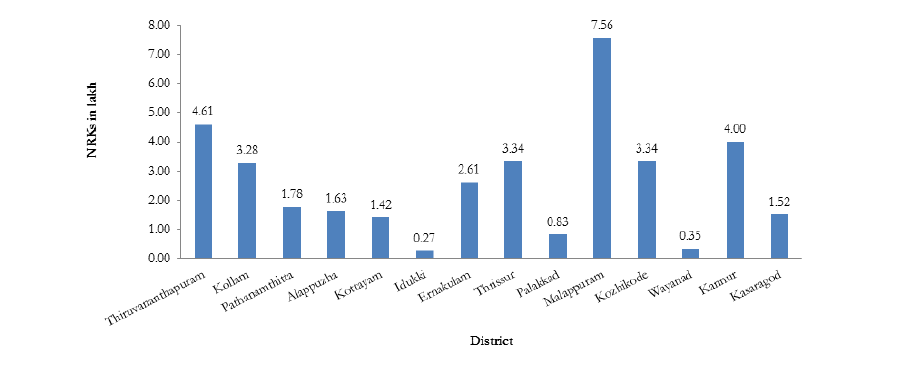 Source: Kerala Migration Survey,2014, State Planning Board, GOK
Source: Kerala Migration Survey,2014, State Planning Board, GOK
During 2011 to 2014, the increase in Non Resident Keralites is 2.22 lakh. The highest increase was in Malappuram (1.93 lakh), followed by Pathanamthitta (0.71 lakh) and Ernakulam (0.62 lakh). District-wise increase and decrease of NRKs in the State is given in Figure 4.4.2. Details of NRKs over the period across the State are given in 4.4.1.
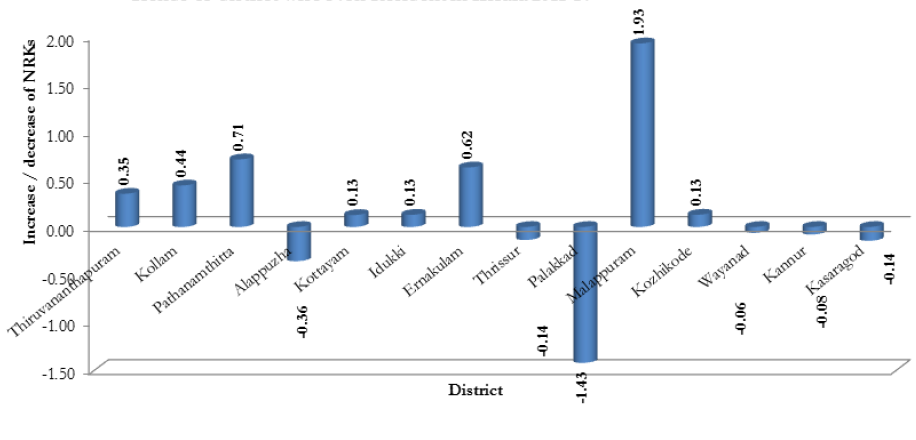 Source: Kerala Migration Survey,2014,State Planning Board, GOK
Source: Kerala Migration Survey,2014,State Planning Board, GOK
Emigration from Kerala
The flow of emigrants from Kerala to other parts of the world has been declining over the years. As compared to the period 1998-03, the additional emigrants from Kerala has reduced from 4.77 lakh to 1.19 lakh during 2011-14. District wise emigrants from Kerala during different periods are given in Figure 4.4.3. The details of district wise number of emigrants from Kerala are given in Appendix 4.4.2.
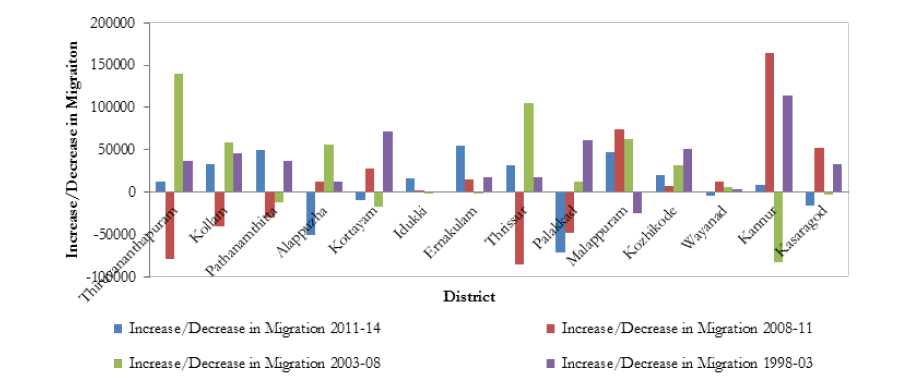 Source: Kerala Migration Survey,2014,State Planning Board, GOK
Source: Kerala Migration Survey,2014,State Planning Board, GOK
District-Wise Proportion of Emigrants in Kerala
In Malappuram, Kannur and Kasargod districts, the proportion of emigrants to total emigrants from the State increased in 2014 compared to 2008. Malappuram has the highest proportion of emigrants (19.1 per cent) followed by Kannur (12 per cent). In Thiruvananthapuram, Palakkad and Thrissur districts, the proportions of emigrants have declined. Highest decline was in Palakkad from 9 per cent to 3 per cent. District-wise proportion of emigrants from Kerala is given in Figure 4.4.4.
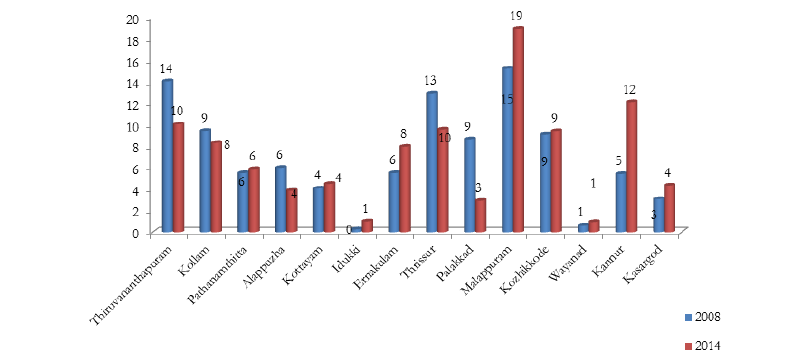 Source: Kerala Migration Survey,2014, State Planning Board, GOK
Source: Kerala Migration Survey,2014, State Planning Board, GOK
Return Emigrants
Due to the nationalisation policy of Middle East and subdued economic growth all over the world, the number of return emigrants to Kerala is increasing. Total return emigrants increased from 7.3 lakh in 1998 to 12.5 lakh in 2014. Figure 4.4.5 shows the increasing trend of return migrants to Kerala.
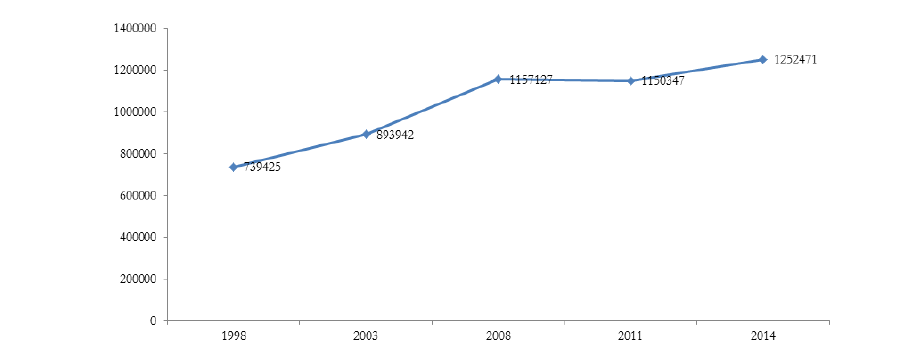
The highest return emigrants is seen in Malappuram followed by Thiruvananthapuram and Kottayam. The district-wise trend of return migrant to the State is given in Figure 4.4.6. The details of the return migrants during different periods are given in Appendix 4.4.3.
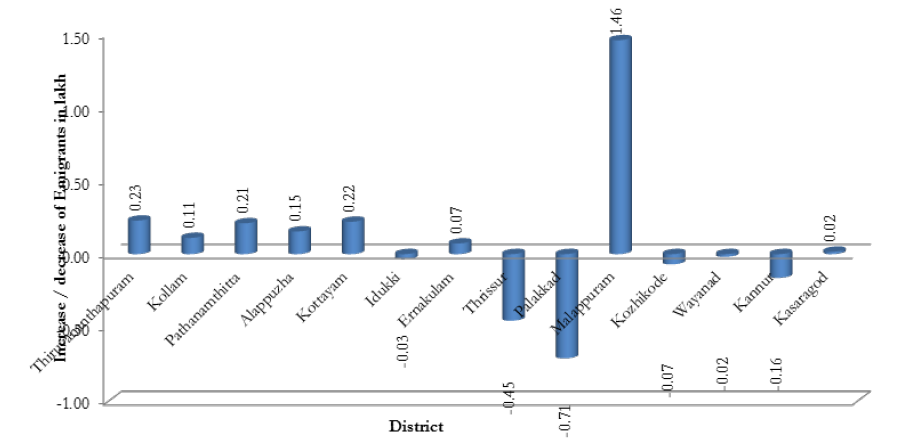 Source: Kerala Migration Survey, 2014, State Planning Board, GOK
Source: Kerala Migration Survey, 2014, State Planning Board, GOK
Destination of Emigrants of Kerala
Country wise destination of emigrants from Kerala shows that 37.5 per cent are in UAE and 21.8 per cent in Saudi Arabia. Out of the total emigrants, 86.3 per cent are residing in West Asia. Emigrants residing in UK, Canada and other South East Asian countries are increasing over the years. Country wise destination of total emigrants from Kerala for the period 2008 and 2014 is given in Figure 4.4.7.
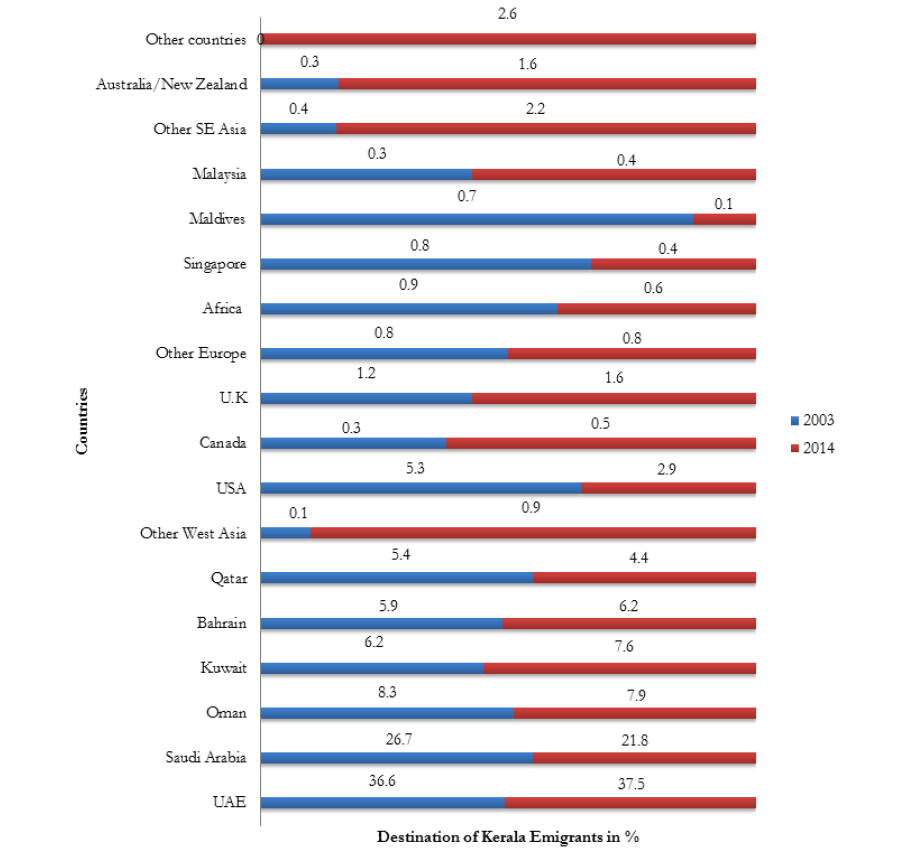 Source: Kerala Migration Survey,2014, State Planning Board, GOK
Source: Kerala Migration Survey,2014, State Planning Board, GOK
Recognition of the diaspora is very crucial and one of the effective ways is to provide a forum for representation where they can associate and link to their home State. Considering the importance of the interaction between State and NRKs, the Loka Kerala Sabha will be formed with members of the State Legislative Assembly and representatives of NRKs nominated by the State Government in proportion to the percentage of population of NRKs in host countries/regions. This Sabha will discuss and deliberate on issues related to NRKs and will help in forging a link between Kerala existing within and outside the State. This Sabha, which will meet at least twice in a year, will be advisory in nature and will provide a forum to voice the concerns of NRKs and also contribute towards policy formulation.
Profession-Wise NRKs
In recent years, the pattern of emigration has changed in respect of the profession they seek abroad. In the 1970s, the proportion of skilled workforce in the total emigrants was very small. Now larger number of skilled workforce from different professions such as doctors, nurses, engineers, IT professionals, teachers, etc. seek employment outside the country. Distribution of NRKs by profession showed that 11.85 per cent of them are working as drivers, 10.99 per cent as salesmen, 6.37 per cent as nurses, 3.78 per cent as engineers, 2.23 per cent as IT professionals and 0.53 per cent as doctors and the remaining 67.78 per cent are professionals like businessman, teachers, bank professional, etc.
Among the doctors, the highest share is from Thiruvananthapuram at 14.39 per cent followed by Kottayam and Ernakulam at 14.38 per cent and 14.34 per cent respectively. The lowest share is from Wayanad. In case of nurses, the highest proportion is from Kottayam at 23.73 per cent followed by Pathanamthitta (20.75 per cent) and Ernakulam (18.16 per cent). For Engineers, Ernakulam has the highest proportion of 13.47 per cent, followed by Thrissur (13.23 per cent) and then Kottayam (10.11 per cent). Among teachers, Pathanamthitta has the highest share of 16.69 per cent followed by Alappuzha at 15.99 per cent and then Kottayam at 9.74 per cent. Figure 4.4.8 shows the district wise number of NRKs working in different jobs abroad.
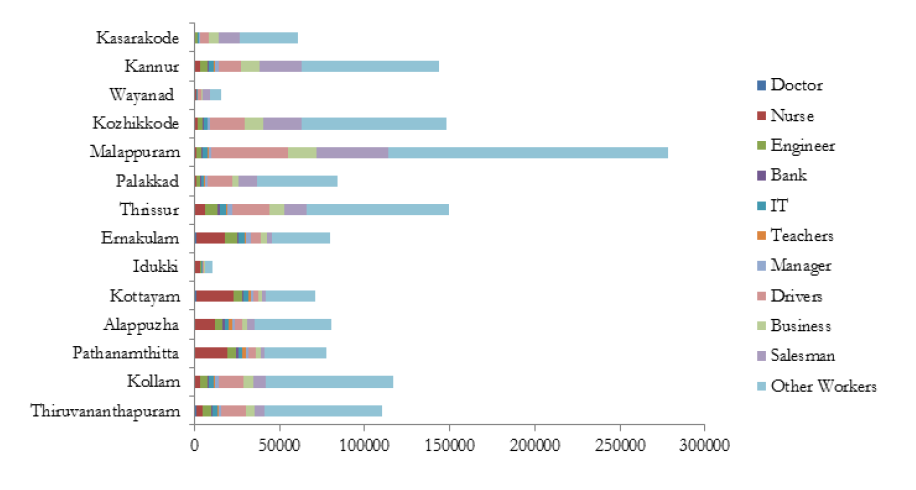 Source: Economic and Statistics Department, GOK.
Source: Economic and Statistics Department, GOK.
The State Government recognizes the vital role of Non-Resident Keralites in the socio, economic, political, cultural development of the State and is prepared to work towards addressing all the concerns and issues of NRKs through an innovative approach in the coming five years.
Rehabilitation of Return Migrants- The aim of the scheme is to reintegrate returned emigrants by helping them to find suitable employment/self employment as a step towards their rehabilitation. Government has formulated Norka Department Project for Return Emigrants (NDPREM) to develop a sustainable business model. The project envisages providing a capital subsidy of 15 per cent of the total project cost as a backend subsidy and 3 per cent of interest subvention to eligible entrepreneurs among return emigrants who wish to start their own ventures in the field of agri-business,training,services and manufacturing.
Santhwana- This scheme is for providing financial assistance to NRKs (returnees) whose minimum period of service abroad is of two years and the period after return does not exceed 10 years. For medical assistance 50,000 is provided and a maximum 100,000 is provided as death assistance. Marriage assistance is 15,000 and for wheel chair crèches and artificial limbs, 10,000 is provided as assistance. There are 2,700 NRKs who have benefitted from the scheme in 2015-16 and 2016-17.
Swapna Saphalyam- The lower segments of Non–Resident Keralites working abroad especially in Gulf countries are subjected to various miseries due to lack of labour protection rules. It is estimated that 1,200 Indians are jailed in Saudi Arabia alone, of which 50 per cent being NRKs.The scheme is to address those NRKs jailed abroad for no wilful default on their part and aims to provide free air tickets when they are released from jails and are not able to afford the tickets.
Pravasi Legal Assistance (Pravasi Legal Aid Cell)- One of the major problems faced by the migrant workers from Kerala to the Middle East Countries is the court cases and other legal problems they get into. In the absence of any sort of legal help, the poor workers end up in the jail. This happens even in the cases of minor offence or sometimes where no offence has been committed. Government proposes to extend legal assistance, including appearance in courts abroad, through the Indian Diplomatic Missions or through advocates empaneled by the Indian Mission.
24 Hours Help Line/Call Centres- The scheme intends to disseminate information on various schemes/projects implemented by Government and NORKA ROOTS, redress grievances of NRKs, conduct counselling to NRKs who are in distress, create awareness among emigrants and prospective emigrants against illegal exploitation, migration etc. and to act as a frontline service facilitator/one point client interaction point for NRKs. It also aims to provide need-based information and assistance to emigrants through the proposed helpline.
Pre Departure Orientation Programme- There is lack of awareness among people in matters connected with emigration in general and overseas job in particular. The scheme is intended to impart orientation and training to these prospective emigrants before departing to their destination countries so as to ensure legal migration. The widespread rural penetration of this scheme will limit cases of illegal migration and exploitation by unscrupulous recruiting agents.